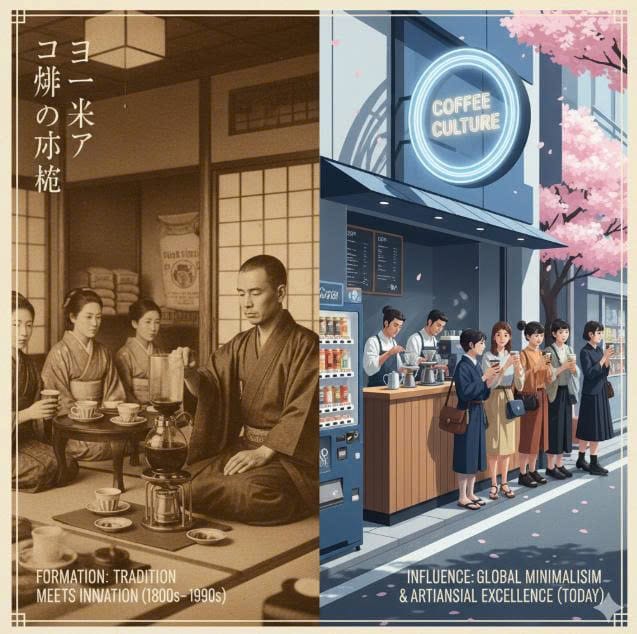In the global coffee landscape, Japan’s coffee culture stands out as truly unique. Despite ranking only 11th in population and 63rd in land area, Japan is the world’s fourth-largest coffee consumer. Its coffee culture has left a strong mark not only in Asia but across the world. From pour-over to canned coffee, from drip bags to deep roasting, Japan has absorbed Western influences and transformed them through localization and innovation, gradually shaping a distinctive coffee culture of its own.
The Historical Development of Japanese Coffee Culture
- Early Entry: 17th Century to Late 19th Century
Coffee first entered Japan in the 17th century, introduced by Dutch traders in Nagasaki. During Japan’s closed-door policy, coffee was only accessible to officials and merchants. Deeply rooted in tea traditions, Japanese people initially found coffee’s “strange taste” unappealing. The turning point came in 1858, when the Treaty of Amity and Commerce with the United States opened Japan to foreign trade, and coffee began to gain traction.
In 1888, Japan’s first café, Kahisakan, opened in Tokyo. Although it closed five years later due to financial difficulties, it became the prototype of Japanese coffeehouses and a milestone in the nation’s coffee history.
- War and Recovery: Early 20th Century
During World War II, coffee imports were severely restricted and at times completely banned. After Japan’s defeat, coffee imports resumed in 1950 and were fully liberalized by 1960. With economic recovery, coffee consumption steadily grew among the public.
- Canned Coffee and Mass Coffee Culture: 1960s–1980s
In 1969, UCC introduced the world’s first canned coffee, revolutionizing convenience in coffee consumption. Soon, canned coffee and vending machines became defining symbols of Japanese urban life.
By 1982, coffee had reached its peak popularity, with 162,000 coffeehouses nationwide. Coffee had fully transformed from a Western import into an integral part of Japanese daily life.
- International Brands and Specialty Coffee: 1990s to Present
In 1996, Starbucks opened its first store in Tokyo’s Ginza district. Its dark roast coffee culture unexpectedly resonated with Japanese consumers, sparking a new wave of coffee enthusiasm. Later, Blue Bottle and other specialty coffee brands entered the market, further promoting the specialty coffee trend. The founding of the Specialty Coffee Association of Japan (SCAJ) in 2003 marked a new stage of quality-driven coffee culture in Japan.
Innovations in Japanese Coffee
- Canned Coffee
The idea of canned coffee was born when UCC founder Tadao Ueshima missed his morning coffee while rushing for a train. This small inconvenience inspired a revolutionary product that soon became ubiquitous. Canned coffee not only spread across Japan but also became a cultural symbol, appearing frequently in anime and films.
- Drip Bag Coffee
In the 1990s, Japanese companies refined the design of drip bag coffee, making it commercially viable. Combining the convenience of instant coffee with the flavor of hand-brewed coffee, drip bags quickly spread across East Asia and eventually the world. Today, they represent a balance between practicality and quality.
These two innovations embody Japan’s obsession with coffee and demonstrate how innovation driven by passion can influence global coffee culture.
Key Brands and Industry Landscape
- UCC
As the pioneer of Japan’s coffee industry, UCC established a vertically integrated model covering every stage “from farm to cup.” Beyond creating canned coffee, UCC invested in Blue Mountain plantations in Jamaica, fueling the global “Blue Mountain boom” of the 1990s.
- AGF
Founded in 1945, AGF became famous for its Maxim instant coffee and Blendy series, which remain core products to this day.
- Doutor Coffee
As Japan’s first domestic coffeehouse chain, Doutor opened its first shop in Harajuku in 1980. At its peak, it had more than 1,300 stores nationwide. Known for affordability, it offered coffee at nearly half the price of Starbucks, making it the everyday choice for many Japanese consumers.
Other major local brands include KEY Coffee and Suntory’s BOSS Coffee. Meanwhile, foreign brands like Starbucks and Blue Bottle found fertile ground in Japan’s thriving coffee ecosystem, blending with local traditions.
Coffee as a Way of Life
In Japan, coffee is not merely a beverage but a lifestyle and cultural expression.
Social Function: Coffeehouses became hubs for intellectual discussion, dating, and relaxation.
Daily Convenience: Canned and drip bag coffee allowed people to enjoy coffee anywhere, anytime.
Unique Styles: Japan developed distinctive traditions such as deep roast and iced coffee.
Aesthetic Pursuit: Brewing methods like pour-over and siphon not only highlight flavor but also reflect Japanese attention to detail and aesthetics, echoing cultural parallels with the tea ceremony and culinary presentation.
Though Japan’s coffee history spans less than 200 years, its impact on global coffee culture is profound. From canned coffee and drip bags to its embrace of specialty coffee, Japan has consistently combined innovation, aesthetics, and practicality. For the Japanese, coffee is more than a stimulant; it is an art form, a lifestyle, and a cultural bridge connecting Japan with the wider world.

